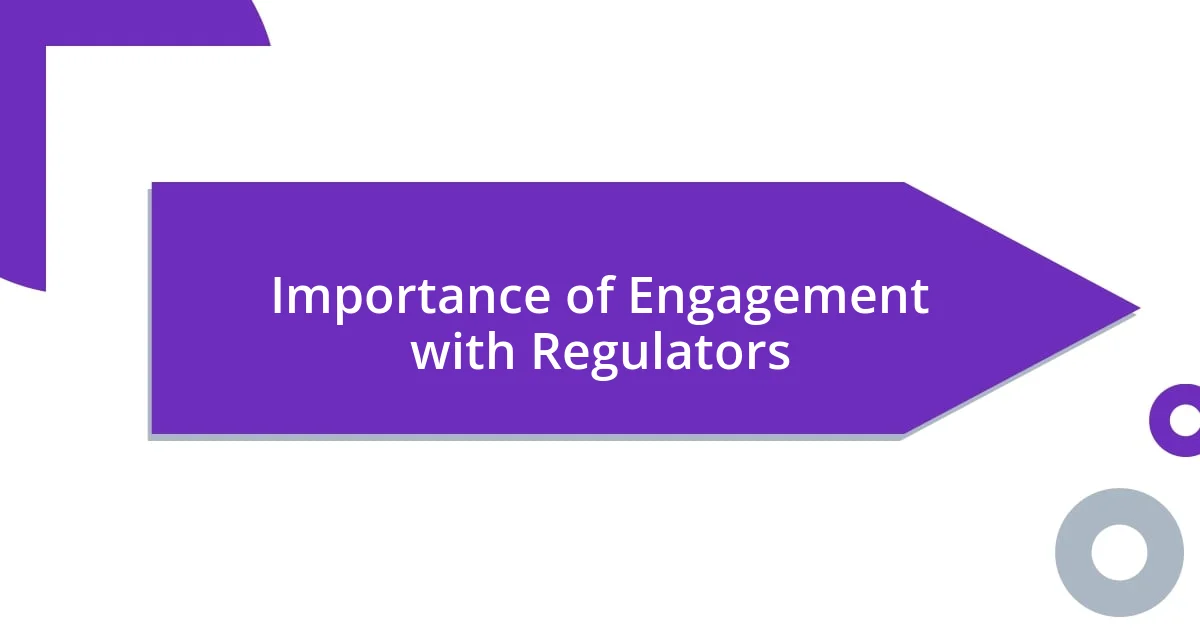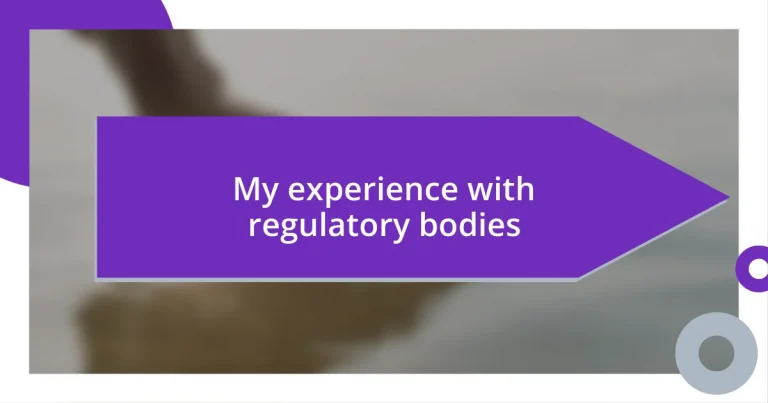Key takeaways:
- Engaging with regulatory bodies fosters collaboration and innovation, allowing businesses to navigate compliance more effectively.
- Effective communication, including active listening and clear messaging, builds trust and strengthens relationships with regulators.
- Building long-term relationships through honesty, personal connections, and consistent follow-ups enhances cooperation and creates a supportive regulatory environment.

Understanding Regulatory Bodies
Regulatory bodies play a crucial role in maintaining standards across various industries, ensuring safety, fairness, and accountability. I remember attending a compliance seminar where a representative from a regulatory agency shared anecdotes about the real-world impact of their decisions. It made me realize how these bodies aren’t just distant authorities; they’re often the voices advocating for public interest, making me wonder how easily we take their work for granted.
In my experience, interacting with regulatory bodies can sometimes feel daunting, but it’s essential to view them as partners rather than adversaries. I recall my first encounter with a regulatory body while seeking approval for a new product; the rigorous requirements felt overwhelming at first. However, over time, I learned that their intent is to safeguard not just consumers but also businesses by fostering a fair market environment.
As I delved deeper into my industry, I found that understanding the principles behind regulatory bodies enhances compliance strategies. Have you ever considered how regulations might actually spark innovation rather than stifle it? I’ve seen firsthand how businesses that embrace these guidelines often end up leading their sectors, adapting more swiftly to change, and ultimately benefiting from the trust gained from customers and stakeholders alike.

Importance of Engagement with Regulators
Engaging with regulatory bodies is not just a necessity; it can be transformative. When I was developing a compliance framework at my organization, I found that proactive engagement with regulators opened up a channel for dialogue that facilitated collaboration rather than confrontation. I vividly recall a time when a simple question I posed during a meeting led to valuable feedback that significantly improved our compliance documentation. It taught me that regulators can act as mentors, guiding businesses toward fulfilling their obligations while also understanding industry challenges.
The relationships we cultivate with regulators can truly shape our operational landscape. During a recent project, we collaborated with a regulatory agency to pilot a new technology. The support we received was remarkable, allowing us to navigate complex regulations with ease. In my opinion, these interactions can lead to not just compliance but innovation, fostering a mutually beneficial outcome that enhances industry standards while addressing public concerns.
Moreover, engaging with regulators enhances transparency and trust. I recall a particular instance where we facilitated a workshop with a regulatory body. The open discussions that emerged from this event broke down previous barriers and clarified expectations. The positive response from both our team and the regulators reassured us that transparency could turn potential conflicts into opportunities for growth. Isn’t it amazing how a shift in perspective can lead to such fruitful collaborations?
| Aspect | Benefits of Engagement with Regulators |
|---|---|
| Compliance Improvement | Access to clearer guidelines and requirements |
| Innovation Support | Regulators can become collaborative partners in new projects |
| Trust Building | Open dialogue fosters trust between industry and regulatory bodies |

My Initial Challenges with Compliance
Initially, navigating compliance felt like wandering through a dense forest without a map. I remember feeling overwhelmed by the sheer volume of regulations and standards I was supposed to understand. The documentation was massive and often seemed to blur into a sea of legalese, leaving me anxious about making a misstep.
Here are some of the key challenges I faced:
- Complex Language: Regulations were often written in dense, technical terms that felt alien to me.
- Ambiguous Guidelines: Sometimes, the guidelines lacked clarity, making it hard to know if I was on the right track.
- Fear of Non-compliance: The thought of inadvertently violating a regulation was stressful, creating a constant sense of unease.
- Time Constraints: Balancing compliance tasks with everyday responsibilities made the process feel even more daunting.
Over time, it became clear how these early hurdles shaped my approach to compliance. One instance stands out vividly—a meeting with a regulatory official where I was genuinely unsure about my understanding of a crucial requirement. My heart raced as I sought clarification, fearing judgment for my ignorance. However, the official not only clarified the issue but also shared resources that made everything much more accessible. This experience taught me that while the compliance journey may be challenging, it can also offer valuable learning opportunities and unexpectedly supportive connections.

Effective Communication Strategies
Effective communication strategies are essential when navigating the complexities of regulatory environments. In my experience, clear and concise messaging is crucial. I recall a situation where we prepared a detailed report for a regulator, ensuring it was not only thorough but also easily digestible. This clarity not only impressed them but created a rapport that led to productive follow-up discussions. Have you ever noticed how a well-crafted message can open doors? I certainly have.
Listening is just as important as speaking in these interactions. I remember attending a session where regulators shared their perspectives on industry trends. By actively listening and asking thoughtful questions, I was able to grasp their expectations better. This engagement laid the groundwork for a more meaningful relationship, as they felt heard and appreciated. How often do we underestimate the power of listening in building trust?
Moreover, using visual aids can significantly enhance communication. During one regulatory meeting, I incorporated infographics to illustrate compliance processes, which caught their interest and fostered a vibrant dialogue. Visuals foster understanding and retention, which is essential in such a detail-oriented field. Isn’t it fascinating how a simple graphic can transform the dynamics of a discussion? Embracing these techniques not only streamlines information sharing but also strengthens the collaborative spirit with regulators.

Navigating Regulatory Processes Efficiently
Navigating regulatory processes efficiently requires a strategic approach that blends organization with proactive engagement. I learned this firsthand when I started creating a comprehensive checklist that outlined key regulatory milestones. The sense of clarity that came from having a visual roadmap was transformative; it helped me prioritize tasks and track deadlines, ultimately reducing the overwhelm that initially plagued me. Have you ever found that something as simple as a checklist can make a daunting project feel manageable? I certainly have.
In addition, I discovered the importance of leveraging technology to streamline compliance tasks. I remember implementing a project management tool that allowed my team to collaborate in real-time. Setting reminders for important dates and maintaining a shared document space not only enhanced efficiency but also fostered greater accountability among team members. I must say, it was rewarding to see how a small tech upgrade made such a difference—who knew that digital tools could turn chaos into order?
Finally, engaging with regulatory bodies on a more informal level helped immensely. I attended networking events where I could speak casually with regulators, which built rapport and made future discussions feel less intimidating. These conversations were often enlightening, shedding light on their expectations and how they interpret regulations. It’s interesting to see how a friendly chat can pave the way for smoother regulatory interactions down the road, isn’t it?

Lessons Learned from My Experience
Reflecting on my journey with regulatory bodies, I discovered the power of adaptability. There was a time when I clung tightly to our initial plans for compliance, only to find that flexibility was key when unexpected roadblocks arose. When we shifted our approach mid-project, I felt a wave of relief wash over me. Have you ever experienced that moment when letting go of rigid plans opens up new possibilities? The sense of empowerment in adapting not only helped us meet the requirements, but it fostered a culture of innovation within our team.
I also learned about the significance of thorough preparation. In one instance, we faced a surprise audit that could have derailed our progress. Thankfully, my team and I had spent weeks meticulously organizing our documentation. As I watched the auditors leave with satisfied nods, I couldn’t help but feel a surge of pride. Isn’t there something immensely gratifying about being ready for the unexpected? From that day on, I understood that preparedness is not just a box to check; it’s a mindset that can lead to success.
One of the most insightful lessons was appreciating the impact of personal relationships in this realm. During a crucial meeting, I shared a personal story related to our compliance efforts, hoping to connect on a human level. The room shifted; suddenly, we were not just discussing regulations but forging connections. Have you seen the difference an authentic story can make in professional settings? That day taught me that behind every regulation, there are people eager to relate, and building those connections can pave the way for smoother collaboration.

Building Long-Term Relationships with Regulators
Building long-term relationships with regulators is all about trust and transparency. I distinctly remember a quarterly meeting where I openly discussed our compliance challenges instead of glossing over them. The unexpected outcome was that regulators appreciated my honesty, which made them more willing to provide guidance and insight. Have you ever realized how vulnerability can lead to stronger partnerships? For me, it was a turning point that reinforced the importance of open communication.
I find that nurturing these relationships extends beyond formal meetings. During one casual lunch with a regulator, we shared stories about our families and hobbies, which unexpectedly created a sense of camaraderie. That personal connection made future discussions much smoother and helped break down barriers. Have you ever had a conversation that transformed a professional relationship into something more genuine? Those moments remind me that people are at the heart of every regulatory process, and investing in relationships pays off in dividends later on.
Moreover, I believe consistency is crucial in maintaining these connections. I made it a point to follow up with regulators after major milestones, not just when issues arose. Sending a simple “thank you” email or sharing positive feedback about their support reinforced that our relationship was a two-way street. It made me reflect—how often do we take the time to acknowledge others in our professional lives? I genuinely believe that fostering these interactions contributes significantly to a more collaborative regulatory landscape.














